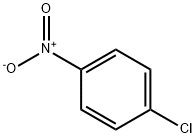P-클로로니트로벤젠 C화학적 특성, 용도, 생산
물리적 성질
p-Nitrochlorobenzene is a yellow crystalline solid with a sweet odor.
화학적 성질
4-Chloronitrobenzene is a light yellow monoclinic prisms crystallizes, which are insoluble in water and very soluble in toluene, ether, acetone, or hot ethanol. It is incompatible with strong oxidizers and alkalis. It is extensively used in different industries as an intermediate in the manufacture of dyes, rubber, and agricultural chemicals.
용도
4-Nitrochlorobenzene is an important intermediate in the manufacture of azo dyes and sulfide dyes, the drugs finasteride and paracetamol, the pesticide herbicide, etc. It is also the raw material of rubber antioxidant 4010.
정의
ChEBI: 4-Chloronitrobenzene is a C-nitro compound.
일반 설명
Light yellow crystalline solid. Density 1.520 g / cm3. Melting point 83°C. Sweet odor. Very toxic by inhalation, ingestion, and skin absorption. p-Chloronitrobenzene is extensively used in different industries as an intermediate in the manufacture of dyes, rubber, and agricultural chemicals. It is incompatible with strong oxidisers and alkalis.
공기와 물의 반응
Insoluble in water.
반응 프로필
4-Chloronitrobenzene reacts with oxidizing agents. Reacts violently and finally explosively when added to a solution of sodium methoxide in methanol. . Unstable when heated.
위험도
A questionable carcinogen. Very toxic by
inhalation and ingestion. Absorbed via skin. Combustible. Methemoglobinemia.
건강위험
Repeated exposure to high levels of p-chloronitrobenzene causes adverse health effects.
The symptoms of toxicity include, but are not limited to, anoxia, unpleasant taste, anemia, methemoglobinemia, hematuria (blood in the urine), spleen, kidney, bone marrow
changes, and reproductive effects. The target organs of p-chloronitrobenzene poisoning
have been identifi ed as the blood, liver, kidneys, cardiovascular system, spleen, bone
marrow, and reproductive system.
화재위험
4-Chloronitrobenzene is combustible.
Safety Profile
Confirmed carcinogen
with experimental carcinogenic data. A
poison by ingestion. Experimental
reproductive effects. Mutation data
reported. Flammable liquid when exposed to
heat, sparks, or flame. May explode on
heating. Potentially violent reaction with
sodium methoxide. When heated to
decomDosition it emits very toxic fumes of NOx and Cl-. See also other
chloronitrobenzene entries and NITRO
COMPOUNDS OF AROMATIC
HYDROCARBONS.
잠재적 노출
p-Nitrochlorobenzene (PNCB) is used
as an intermediate in pesticide (parathion) manufacture,
drug (phenacetin and acetaminophen) manufacture; and in
dye making; rubber and antioxidant manufacture.
Carcinogenicity
No increase in tumor incidence was seen
in rats fed up to 1000 ppm in the diet for 2
years; in mice, results were equivocal, with
high-dose animals showing an increase in vascular
tumors and low-dose males showing an
increase in liver tumors.6 The IARC has determined
that there is inadequate evidence in
experimental animals and humans for the carcinogenicity
of chlorobenzenes.7
운송 방법
UN1578 Chloronitrobenzenes, solid or liquid,
Hazard Class: 6.1; Labels: 6.1-Poisonous materials.
Purification Methods
Crystallise the nitrobenzene from 95% EtOH (charcoal) and sublime it in vacuo. [Emmons JAm Chem Soc 76 3470 1954, Newman & Forrest J Am Chem Soc 69 1221 1947, Beilstein 5 IV 723.]
비 호환성
A strong oxidizer. Reacts violently with
oxidizers, combustibles, alkalis, sodium methoxide; and
reducing materials.
폐기물 처리
Incineration (816℃, 0.5 second
for primary combustion; 1204℃, 1.0 second for secondary
combustion). The formation of elemental chlorine
can be prevented through injection of steam or methane
into the combustion process. nitrogen oxides may be abated
through the use of thermal or catalytic devices.
P-클로로니트로벤젠 준비 용품 및 원자재
원자재
준비 용품









